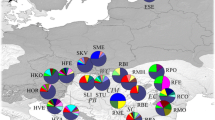Abstract
We studied allozyme and chloroplast (cp) DNA variation in natural populations of Pinus kesiya and P. merkusii from Thailand and Vietnam. The results showed striking differences between the two species in the amount and distribution of allozyme variation. P. kesiya harboured considerable allozyme variation and showed weak interpopulational differentiation. In contrast, P. merkmii had very low intrapopulational variability but a high level of interpopulational differentiation. The average Nei's genetic distance separating the two species was exceptionally high (0.701) taking into account their close taxonomic placement in the same subsection Sylvestres. The constructed phylogenetic trees revealed very early divergence of P. kesiya and P. merkusii. The present analysis of cpDNA variation also confirmed the dissimilar character of these two species and was compatible with other evidence indicating the outstanding position of P. merkusii as compared to other Asian members of the subsection Sylvestres. Analysis of cpDNA variation in sympatric populations of P. kesiya and P. merkusii revealed that they are pure representatives of the species in question. This result indicates that despite an overlapping distribution P. kesiya and P. merkusii do not hybridise in nature. We suggest that the distinctive character of P. merkusii is a result of an early separation from other Eurasian pines. Despite spatial proximity, P. kesiya and P. merkusii are kept apart by strong reproductive barriers. The low genetic variability of P. merkusii may be explained by previous bottlenecks, reduced gene flow among populations, and an inbreeding due to small population size and asynchronous flowering.
Similar content being viewed by others
References
Armitage FB, Burley J (1980) Pinus kesiya Royle ex Gordon. Unit of Tropical Silviculture, Commonwealth Forestry Institute, University of Oxford, England
Boyle TJB, Liengsiri C, Piewluang C (1991) Genetic studies in a tropical pine — Pinus kesiya. II. Genetic variation among four populations in northern Thailand. J Trop For Sci 3:308–317
Cavalli-Sforza LL, Edwards AWF (1967) Phylogenetic analysis: models and estimation procedures. Evolution 21:550–570
Changtragoon S, Finkeldey R (1995) Genetic variation of Pinus merkusii in Thailand. I. Genetic analysis of isozyme phenotypes. J Trop For Sci (in press)
Changtragoon S, Finkeldey R (1995) Patterns of genetic variation and characterization of the mating system of Pinus merkusii in Thailand. For Genet 2:105–115
Cooling ENG (1968) Pinus merkusii. Commonwealth Forestry Institute, Department of Forestry, University of Oxford, England
Coppen JJW, Gay C, James DJ, Robinson JM, Supriana N (1993) Variability in xylem resin composition amongst natural populations of Indonesian Pinus merkusii. Phytochemistry 33:129–136
Critchfield WB, Little EL (1966) Geographic distribution of the pines of the world. USDA/Forest Service Misc Publ 991:1–29
Farjon A (1984) Pines: drawings and descriptions of the genus. E. Brill/D. R. Backhuys, Leiden, The Netherlands
Farris JS (1972) Estimating phylogenetic trees from distance matrices. Am Nat 106:645–668
Karalamangala RR, Nickrent DL (1989) An electrophoretic study of representatives of subgenus Diploxylon of Pinus. Can J Bot 67:1750–1759
Lidholm J, Gustafsson P (1991) The chloroplast genome of the gymnosperm Pinus contorta: a physical map and a complete collection of overlapping clones. Curr Genet 20:161–166
Millar CI, Strauss SH, Conkle MT, Westfall RD (1988) Allozyme differentiation and biosy stematics of the Californian closed-cone pines (Pinus subsect. Oocarpae). Systematic Bot 13:351–370
Mirov NT (1967) The genus Pinus. The Ronald Press Company, New York
Nei M (1978) Estimation of average heterozygosity and genetic distance from a small number of individuals. Genetics 89:583–590
Nei M (1987) Molecular evolutionary genetics. Columbia University Press, New York
Saitou N, Nei M (1987) The neighbor-joining method: a new method for reconstructing phylogenetic trees. Mol Biol Evol 4:406–425
Son D, Hong S, Yeo J, Ryu I (1989) Genetic variation of isozymes in populations of Pinus densiflora and Pinus thunbergii naturally distributed in Kyungpook province. I Korean For Soc 78:345–359
Styles BT, Burley J (1972) The botanical name of the Khasi pine (Pinus kesiya Royle ex Gordon). Commonwealth For Rev 51:241–245
Swofford DL, Seiander RB (1981) BIOSYS-1: a FORTRAN program for the comprehensive analysis of electrophoretic data in population genetics and systematics. J Hered 72:281–283
Szmidt AE (1982) Genetic variation in isolated populations of stone pine (Pinus cembra L.). Silvae Fenn 16:196–200
Szmidt AE (1984) Genetic studies of Scots pine (Pinus sylvestris L.) domestication by means of isozyme analysis. PhD thesis, Faculty of Forestry, Swedish University of Agricultural Sciences, ISBN 91-576-2123-3
Szmidt AE, Wang X-R (1993) Molecular systematics and genetic differentiation of Pinus sylvestris (L.) and P. densiflora (Sieb, et Zucc.). Theor Appl Genet 86:159–165
Szmidt AE, Lidholm I, Hällgren J-E (1986) DNA extraction and preliminary characterization of chloroplast DNA from Pinus sylvestris and Pinus contorta. In: Lindgren D (ed) Frans Kempe Symposium on Provenances and Forest Tree Breeding for High Latitudes, June 10–11, Umeå, Sweden, pp 269–280
Wang X-R, Szmidt AE (1990) Evolutionary analysis of Pinus densata (Masters), a putative Tertiary hybrid. 2. A study using species-specific chloroplast DNA markers. Theor Appl Genet 80:641–647
Wang XR, Szmidt AE (1993) Chloroplast DNA-based phylogeny of Asian Pinus species (Pinaceae). Pl Syst Evol 188:197–211
Wang X-R, Szmidt AE (1994) Hybridization and chloroplast DNA variation in a Pinus species complex from Asia. Evolution 48:1020–1031
Wang X-R, Szmidt AE, Lewandowski A, Wang Z-R (1990) Evolutionary analysis of Pinus densata (Masters), a putative Tertiary hybrid. 1. Allozyme variation. Theor Appl Genet 80:635–640
Weissmann von G, Lange W (1987) Zusammensetzung der Neutralteile des Balsamkolophoniums von Pinus massoniana Lamb., Pinus merkusii Jungh. und Pinus luchuensis Mayr. Holzforschung 41:147–154
Author information
Authors and Affiliations
Additional information
Communicated by P. M. A. Tigerstedt
Rights and permissions
About this article
Cite this article
Szmidt, A.E., Wang, XR. & Changtragoon, S. Contrasting patterns of genetic diversity in two tropical pines: Pinus kesiya (Royle ex Gordon) and P. merkusii (Jungh et De Vriese). Theoret. Appl. Genetics 92, 436–441 (1996). https://doi.org/10.1007/BF00223690
Received:
Accepted:
Issue Date:
DOI: https://doi.org/10.1007/BF00223690




